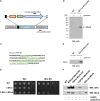The insertion Green Monster (iGM) method for expression of multiple exogenous genes in yeast
- PMID: 24776987
- PMCID: PMC4455768
- DOI: 10.1534/g3.114.010868
The insertion Green Monster (iGM) method for expression of multiple exogenous genes in yeast
Abstract
Being a simple eukaryotic organism, Saccharomyces cerevisiae provides numerous advantages for expression and functional characterization of proteins from higher eukaryotes, including humans. However, studies of complex exogenous pathways using yeast as a host have been hampered by the lack of tools to engineer strains expressing a large number of genetic components. In addition to inserting multiple genes, it is often desirable to knock out or replace multiple endogenous genes that might interfere with the processes studied. Here, we describe the "insertion Green Monster" (iGM) set of expression vectors that enable precise insertion of many heterologous genes into the yeast genome in a rapid and reproducible manner and permit simultaneous replacement of selected yeast genes. As a proof of principle, we have used the iGM method to replace components of the yeast pathway for methionine sulfoxide reduction with genes encoding the human selenoprotein biosynthesis machinery and generated a single yeast strain carrying 11 exogenous components of the selenoprotein biosynthetic pathway in precisely engineered loci.
Keywords: Saccharomyces cerevisiae; flow cytometry; green fluorescent protein; multi-gene insertions; synthetic biology.
Copyright © 2014 Labunskyy et al.
Figures




Similar articles
-
Quantitative proteomic analysis of ribosomal protein L35b mutant of Saccharomyces cerevisiae.Biochim Biophys Acta. 2010 Apr;1804(4):676-83. doi: 10.1016/j.bbapap.2009.10.014. Epub 2009 Oct 29. Biochim Biophys Acta. 2010. PMID: 19879384
-
Preparation of Saccharomyces cerevisiae expression plasmids.Methods Mol Biol. 2012;866:41-6. doi: 10.1007/978-1-61779-770-5_4. Methods Mol Biol. 2012. PMID: 22454112
-
The green monster process for the generation of yeast strains carrying multiple gene deletions.J Vis Exp. 2012 Dec 15;(70):e4072. doi: 10.3791/4072. J Vis Exp. 2012. PMID: 23271437 Free PMC article.
-
Improved blue, green, and red fluorescent protein tagging vectors for S. cerevisiae.PLoS One. 2013 Jul 2;8(7):e67902. doi: 10.1371/journal.pone.0067902. Print 2013. PLoS One. 2013. PMID: 23844123 Free PMC article.
-
Knock-in/Knock-out (KIKO) vectors for rapid integration of large DNA sequences, including whole metabolic pathways, onto the Escherichia coli chromosome at well-characterised loci.Microb Cell Fact. 2013 Jun 24;12:60. doi: 10.1186/1475-2859-12-60. Microb Cell Fact. 2013. PMID: 23799955 Free PMC article.
Cited by
-
Mycosynthesis of selenium nanoparticles using Penicillium tardochrysogenum as a therapeutic agent and their combination with infrared irradiation against Ehrlich carcinoma.Sci Rep. 2024 Jan 31;14(1):2547. doi: 10.1038/s41598-024-52982-9. Sci Rep. 2024. PMID: 38291218 Free PMC article.
-
Chemical Inhibition of Pre-mRNA Splicing in Living Saccharomyces cerevisiae.Cell Chem Biol. 2019 Mar 21;26(3):443-448.e3. doi: 10.1016/j.chembiol.2018.11.008. Epub 2019 Jan 10. Cell Chem Biol. 2019. PMID: 30639260 Free PMC article.
-
A natural variant of the essential host gene MMS21 restricts the parasitic 2-micron plasmid in Saccharomyces cerevisiae.Elife. 2020 Oct 16;9:e62337. doi: 10.7554/eLife.62337. Elife. 2020. PMID: 33063663 Free PMC article.
-
Efforts to make and apply humanized yeast.Brief Funct Genomics. 2016 Mar;15(2):155-63. doi: 10.1093/bfgp/elv041. Epub 2015 Oct 13. Brief Funct Genomics. 2016. PMID: 26462863 Free PMC article. Review.
-
Rapid, scalable, combinatorial genome engineering by marker-less enrichment and recombination of genetically engineered loci in yeast.Cell Rep Methods. 2023 May 10;3(5):100464. doi: 10.1016/j.crmeth.2023.100464. eCollection 2023 May 22. Cell Rep Methods. 2023. PMID: 37323580 Free PMC article.
References
-
- Driscoll D. M., Copeland P. R., 2003. Mechanism and regulation of selenoprotein synthesis. Annu. Rev. Nutr. 23: 17–40. - PubMed
-
- Engels B., Dahm P., Jennewein S., 2008. Metabolic engineering of taxadiene biosynthesis in yeast as a first step towards Taxol (Paclitaxel) production. Metab. Eng. 10: 201–206. - PubMed
Publication types
MeSH terms
Substances
Grants and funding
LinkOut - more resources
Full Text Sources
Other Literature Sources
Molecular Biology Databases
Research Materials
